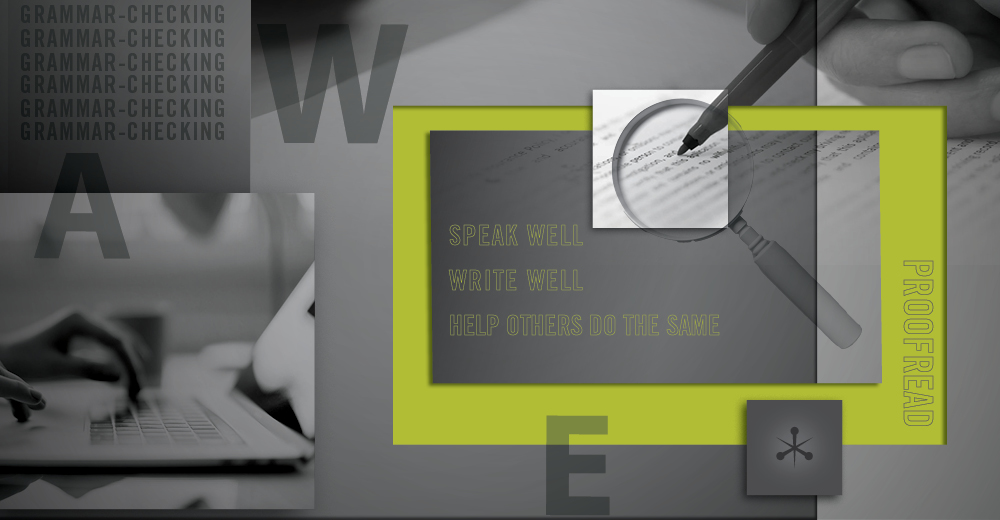March 4 is National Grammar Day. But in this modern age of finger-snap attention spans and content that’s scrolled past before it can even load, is grammar even a “thing” anymore? Should it be? We say “Absolutely!” And we’ll show you why brands that don’t make the quality of their content a top priority are doing so at their own peril.
Quality. We don’t notice when it’s present, but we sure notice when it’s absent. When you go out to eat, do you notice if the silverware is clean? No; you expect it to be spotless, and it usually is. But if there was a big chunk of crud stuck to your fork, would you notice? Yes, and you would tell your server and possibly even the manager. You might even snap a picture of it with your phone before alerting them, so you could later post it on your social media channels and tag the restaurant. You might go so far as posting it on review sites like Yelp to draw even more attention to the restaurant’s unacceptable quality.
Boom. A black eye for the restaurant’s brand.
The clean silverware that we all take for granted is no accident. Clean silverware happens only when 1.) there is a process in place for cleaning it and 2.) that process is diligently followed.
The same is true for your marketing content: The audience expects it to be error-free, but it will be error-free only if you have a content quality process in place — and you diligently follow it.
What might happen if you don’t have this kind of process in place?

The hard costs of errors in your marketing content.
If a brochure with an error makes it to print and costs your business $10,000 to reprint, how much new revenue would you have to generate to make up for the loss? $130,000! Based on an average net profit of 7.71% across all industries, you would have to bring in $130,000 in revenue just to break even for the $10,000 loss — a $10,000 loss that you would have avoided if you had caught the error.
But what if that same error made it onto your website and was seen by a million people before you could correct it? Charles Duncombe, an online entrepreneur quoted by the BBC, said that “a single spelling mistake can cut online sales in half.”
And if that error made it into an online ad, it could increase your Google Ads bill. Shira Stieglitz, head of content and research for Website Planet, discovered that ads with typos resulted in up to 70% fewer clicks than ads without typos. Stieglitz said, “Not only did users notice the typos in the ads and, therefore, click on them less, but Google’s algorithm also picked up on the reduced CTR [click-through rate] and required us to pay more per click.”
So it’s easy to see that errors cost money. But they can cost you so much more.
The soft costs of errors in your marketing content.
Mistakes in your content can also lead to unwanted publicity, which can cost you in terms of “brand equity” — the consumers’ perception of your brand. Just think of the black eye your brand would suffer if your error went viral or ended up on a list of epic marketing fails.
Making matters worse, soft costs inevitably turn into hard costs. When people see mistakes or bad grammar in a brand’s marketing content, they lose confidence in the product or service the brand is asking them to invest in.
What’s a brand to do?
3 tips for eliminating errors from your marketing content.
Tip #1
If you use spellcheck and grammar-checking software, do not trust them implicitly.
“Spelling and grammar tools are great, but they can give you a false sense of security; language is far too nuanced and complex for software to catch everything,” said PJ Myers, content editor at Trilix. “Other areas of weakness are the spelling of names, fact-checking, brand voice and issues with visuals. A human editor can detect and correct problems in these areas, but software can’t — at least not yet!”
Tip #2
If you wrote the copy, have someone else proofread it.
“We can’t see our own errors,” said PJ. “We know what we’re trying to say so our brain ‘corrects’ the missing words, double words and wrong words. But when you have another person proofread your content, those glitches stand out to them like a sore thumb.”
Tip #3
If you don’t have a formal content quality assurance process in place, implement one.
Abby Bottenfield, APR, director of communications at Trilix, had this to say about content quality: “I learned early in my career that if something can go wrong with your content, it will. But when you send content through a formal vetting process, it’s amazing the things you can find and fix. We don’t want anything to leave our door without going through this process at every step.”
The takeaway.
Quality does not happen by itself. The motto of National Grammar Day is “March forth on March 4th to speak well, write well and help others do the same.” Live by this motto, and you just might protect your brand — and your bottom line — from that dreaded black eye.